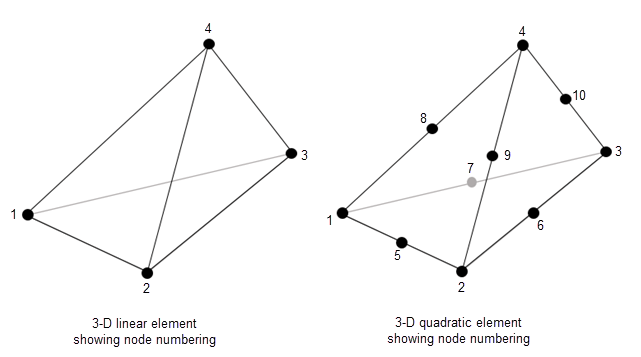Mesh Data
Partial Differential Equation Toolbox™ uses meshes with triangular elements for 2-D geometries and meshes with tetrahedral elements for 3-D geometries. In both cases, it uses the quadratic geometric order by default, and provides the option to switch to the linear geometric order. A mesh always consists of elements of the same order. The toolbox does not support mixed meshes.
Triangular elements in 2-D meshes are specified by three nodes for linear elements or six nodes for quadratic elements. A triangle representing a linear element has nodes at the corners. A triangle representing a quadratic element has nodes at its corners and edge centers.

Tetrahedral elements in 3-D meshes are specified by four nodes for linear elements or 10 nodes for quadratic elements. A tetrahedron representing a linear element has nodes at the corners. A tetrahedron representing a quadratic element has nodes at its corners and edge centers.

The center nodes in quadratic meshes are always added at half-distance between corners. For geometries with curved surfaces and edges, center nodes might not appear on the edge or surface itself.
The model container object stores the parameters of the PDE model. The toolbox offers
several types of model container objects, each for a particular application area. For
example, for linear elasticity problems, the model container is a
StructuralModel object, and for heat transfer problems, the model
container is a ThermalModel object. For general PDE problems, the toolbox
uses the PDEModel object.
The Mesh property of the model container object stores
mesh data. The Mesh property contains a FEMesh object.
FEMesh include information on the nodes and elements of the mesh, mesh growth
rate, and target minimum and maximum element size. The properties also indicate whether the
mesh is linear or quadratic. You can specify these mesh parameters when creating a
mesh.
To generate a mesh for your PDE model, use the generateMesh function.
By default, generateMesh uses the quadratic geometric order,
which typically produces more accurate results than the linear geometric order. To switch to
the linear geometric order, call the mesh generator and set the
GeometricOrder name-value pair to 'linear'.